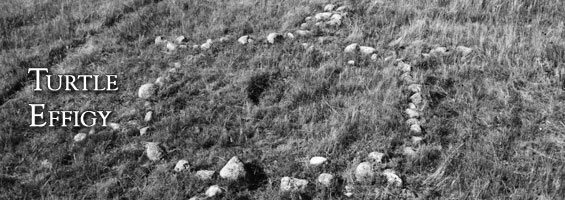We’ve launched a new web portal! Visit findhistory.nd.gov to search our collections.
Due to a road closure, the Killdeer Mountain Battlefield State Historic Site is temporarily closed.

A turtle effigy lies on the edge of a high ridge in Mercer County. This effigy is an animal shape formed by arranging stones in a pattern. The turtle feature measures twenty-one feet from head to tail and eleven and one-half feet from side to side. Ninety-five stones are incorporated into the body, which has six appendages: four legs, a head, and a tail. The head is formed from a dense concentration of stones, but the remainder of the body is outlined by a single course of rocks.
Other prehistoric rock figures have been found on the northern plains. The outlines include human figures, snakes, geometric patterns, medicine wheels (radiating spokes within a circle), bison, birds, parallel or single boulder lines, connecting lines, triangles, crosses, and oblong or elliptical enclosures. These sites are found in Alberta, Manitoba, Saskatchewan, North Dakota, and South Dakota. Similar turtles in our region have been recorded at Cross Ranch, near Sanger, Oliver County; along the Beulah Trench north of Beulah, Mercer County; northwest of Williston, Williams County; near Ludlow Cave, South Dakota; and on Snake Butte, north of Pierre, South Dakota. Although the actual dates of construction of most of these rock outlines are unknown, the degree of sod cover and the amount of lichen growth on the rocks are clues to their age. The clues suggest that the turtle effigy is at least several hundred years old.
The tribal affiliation of the creators of many of these turtle effigies is unknown. Some tribes, however, such as the Ojibwas, Blackfeet, Dakotas (Sioux), Mandans, and Hidatsas, recognize the importance of the turtle in their religious beliefs and hunting ceremonies. Alfred Bowers, an anthropologist who worked with the Mandans and Hidatsas, attributed many of the turtle effigies to members of these two tribes. He reported that the turtle was used in bison-hunting ceremonies:
The turtle is also associated with the buffalo on other occasions. Throughout Hidatsa hunting territory are numerous turtle effigies arranged from boulders and situated on high hills with the head pointed toward the river . . . Nearby are piles of stones on which individual offerings are made to clear the fogs so that the buffalo could be found.
Turtle and other effigies are rare and fragile resources. Vehicle traffic, unauthorized digging, souvenir collection, and cultivation have destroyed many of these sites.
There is not an access road to the Turtle Effigy State Historic Site, which was donated to the state in 1993. For access information, contact the Historic Preservation Division, State Historical Society of North Dakota, 612 East Boulevard Avenue, Bismarck, North Dakota, 58505, or call (701) 328-2666.
SHSND Address:
612 East Boulevard Ave.
Bismarck, North Dakota 58505
Get Directions
SHSND Hours:
Museum Store: 8am - 5pm M-F; Sat. & Sun. 10am - 5pm.
State Archives: 8am - 4:30pm., M-F, except state holidays, and 2nd Sat. of each month, 10am - 4:30 pm.
State Historical Society offices: 8am - 5pm M-F, except state holidays.
Contact SHSND:
phone: 701.328.2666
email: history@nd.gov